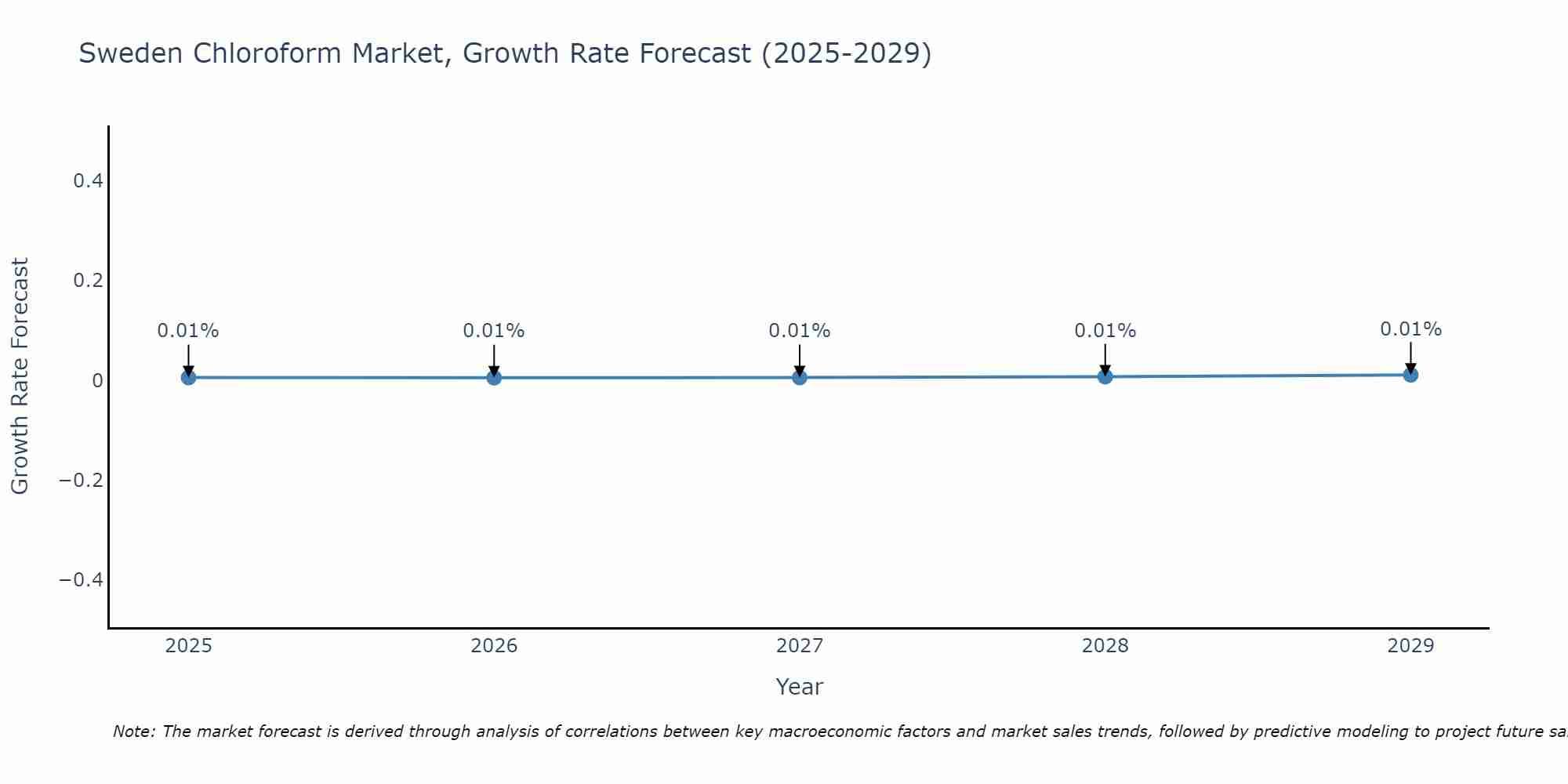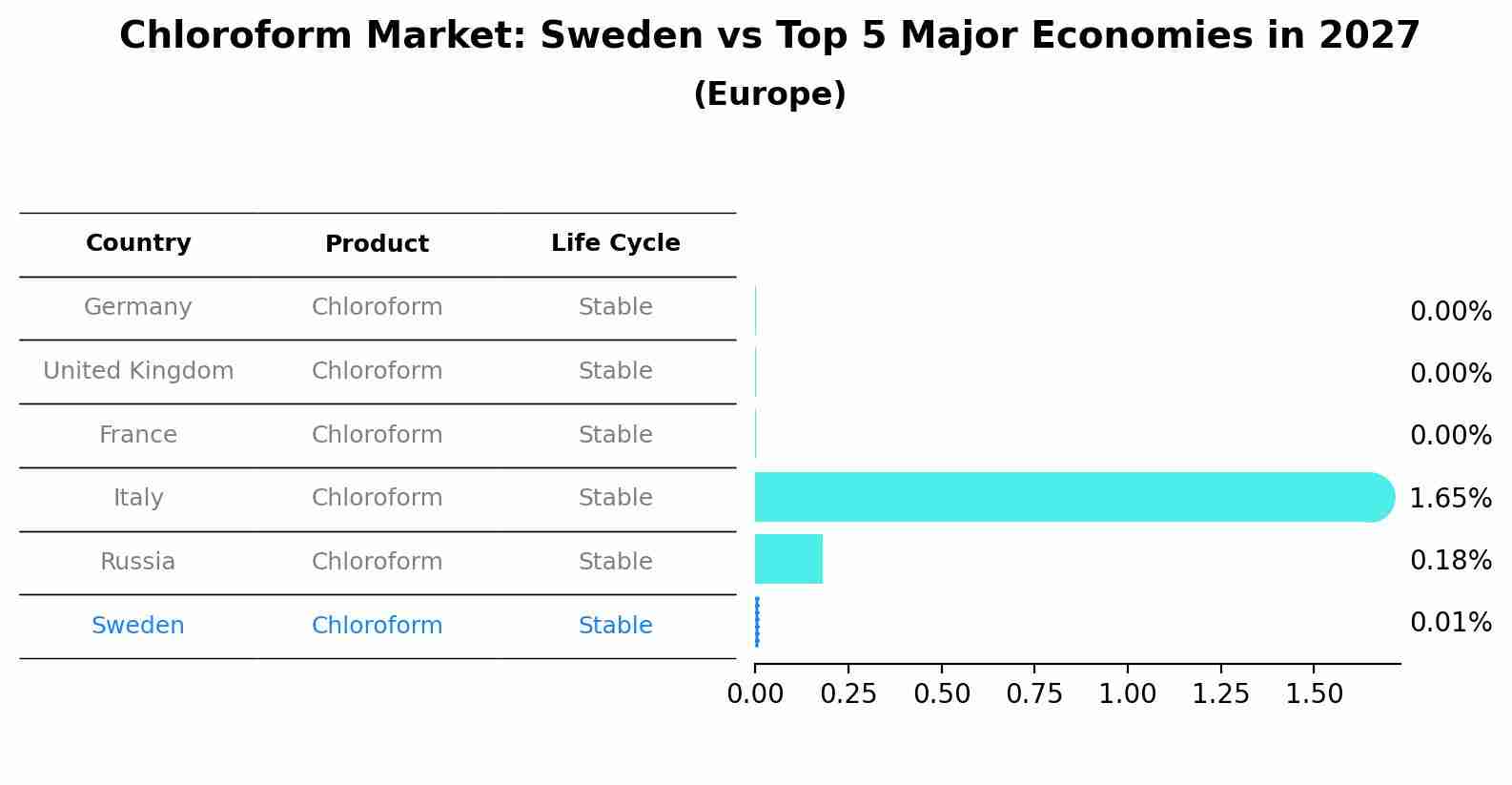Sweden Chloroform Market (2025-2031) | Share, Companies, Forecast, Value, Size, Growth, Trends, Outlook, Revenue, Industry, Analysis & Segmentation
| Product Code: ETC4733977 | Publication Date: Nov 2023 | Updated Date: Sep 2025 | Product Type: Market Research Report | |
| Publisher: 6Wresearch | Author: Shubham Deep | No. of Pages: 60 | No. of Figures: 30 | No. of Tables: 5 |
Sweden Chloroform Market Size Growth Rate
The Sweden Chloroform Market is projected to witness mixed growth rate patterns during 2025 to 2029. From 0.01% in 2025, the growth rate steadily ascends to 0.01% in 2029.

Chloroform Market: Sweden vs Top 5 Major Economies in 2027 (Europe)
The Chloroform market in Sweden is projected to grow at a stable growth rate of 0.01% by 2027, highlighting the country's increasing focus on advanced technologies within the Europe region, where Germany holds the dominant position, followed closely by United Kingdom, France, Italy and Russia, shaping overall regional demand.

Sweden Chloroform Market Overview
Chloroform is utilized in Sweden primarily as a solvent in the pharmaceutical and chemical industries. The chloroform market is experiencing growth due to the increasing demand for pharmaceuticals and agrochemicals, where chloroform is used in synthesis processes. However, the market faces challenges due to environmental concerns associated with chloroform toxicity and potential health risks. Regulatory pressures and the push for safer alternatives may affect the market future trajectory. Nevertheless, ongoing research into safe handling practices and alternative uses may provide opportunities for market stabilization.
Drivers of the market
The growth of the chloroform market in Sweden is primarily driven by its applications in the pharmaceutical and chemical industries. Chloroform is widely used as a solvent in the production of various chemicals, including fluorinated compounds, which are essential in different industrial processes. The expanding pharmaceutical sector, coupled with increasing research and development activities, is further propelling the demand for chloroform. Additionally, the rising focus on developing effective solvents with minimal environmental impact is leading to innovations in chloroform production methods, ensuring sustainable growth for the market.
Challenges of the market
The chloroform market in Sweden is heavily regulated due to the harmful environmental and health effects of chloroform exposure. The market faces difficulties in complying with European Union directives that limit the production and use of chloroform in industrial processes. This has led to a reduction in demand for chloroform, especially in applications where safer alternatives are available. Furthermore, the cost of adhering to environmental and safety regulations is high, and the potential liabilities from accidents or non-compliance further burden market participants. The challenge of finding sustainable and less hazardous substitutes also puts pressure on the chloroform industry.
Government Policy of the market
In Sweden, the chloroform market is regulated due to the chemical hazardous nature and potential health risks. The European Unions REACH regulations and Swedens national chemical safety policies restrict the production and usage of chloroform, particularly in consumer products. These regulations aim to minimize exposure and environmental release of chloroform, which is classified as a potential carcinogen. Moreover, import restrictions and stringent labeling requirements also influence the availability and use of chloroform in various industrial applications, including laboratory use and pharmaceutical manufacturing.
Key Highlights of the Report:
- Sweden Chloroform Market Outlook
- Market Size of Sweden Chloroform Market, 2024
- Forecast of Sweden Chloroform Market, 2031
- Historical Data and Forecast of Sweden Chloroform Revenues & Volume for the Period 2021-2031
- Sweden Chloroform Market Trend Evolution
- Sweden Chloroform Market Drivers and Challenges
- Sweden Chloroform Price Trends
- Sweden Chloroform Porter`s Five Forces
- Sweden Chloroform Industry Life Cycle
- Historical Data and Forecast of Sweden Chloroform Market Revenues & Volume By Grade for the Period 2021-2031
- Historical Data and Forecast of Sweden Chloroform Market Revenues & Volume By Technical Grade for the Period 2021-2031
- Historical Data and Forecast of Sweden Chloroform Market Revenues & Volume By Alcohol Stabilized Grade for the Period 2021-2031
- Historical Data and Forecast of Sweden Chloroform Market Revenues & Volume By Fluorocarbon Grade for the Period 2021-2031
- Historical Data and Forecast of Sweden Chloroform Market Revenues & Volume By Application for the Period 2021-2031
- Historical Data and Forecast of Sweden Chloroform Market Revenues & Volume By Solvent for the Period 2021-2031
- Historical Data and Forecast of Sweden Chloroform Market Revenues & Volume By Intermediates for the Period 2021-2031
- Historical Data and Forecast of Sweden Chloroform Market Revenues & Volume By Reagent for the Period 2021-2031
- Historical Data and Forecast of Sweden Chloroform Market Revenues & Volume By Others for the Period 2021-2031
- Historical Data and Forecast of Sweden Chloroform Market Revenues & Volume By End-users for the Period 2021-2031
- Historical Data and Forecast of Sweden Chloroform Market Revenues & Volume By Pharmaceutical for the Period 2021-2031
- Historical Data and Forecast of Sweden Chloroform Market Revenues & Volume By Agrochemical for the Period 2021-2031
- Historical Data and Forecast of Sweden Chloroform Market Revenues & Volume By Chemical Industry for the Period 2021-2031
- Historical Data and Forecast of Sweden Chloroform Market Revenues & Volume By Others for the Period 2021-2031
- Sweden Chloroform Import Export Trade Statistics
- Market Opportunity Assessment By Grade
- Market Opportunity Assessment By Application
- Market Opportunity Assessment By End-users
- Sweden Chloroform Top Companies Market Share
- Sweden Chloroform Competitive Benchmarking By Technical and Operational Parameters
- Sweden Chloroform Company Profiles
- Sweden Chloroform Key Strategic Recommendations
Frequently Asked Questions About the Market Study (FAQs):
1 Executive Summary |
2 Introduction |
2.1 Key Highlights of the Report |
2.2 Report Description |
2.3 Market Scope & Segmentation |
2.4 Research Methodology |
2.5 Assumptions |
3 Sweden Chloroform Market Overview |
3.1 Sweden Country Macro Economic Indicators |
3.2 Sweden Chloroform Market Revenues & Volume, 2021 & 2031F |
3.3 Sweden Chloroform Market - Industry Life Cycle |
3.4 Sweden Chloroform Market - Porter's Five Forces |
3.5 Sweden Chloroform Market Revenues & Volume Share, By Grade, 2021 & 2031F |
3.6 Sweden Chloroform Market Revenues & Volume Share, By Application, 2021 & 2031F |
3.7 Sweden Chloroform Market Revenues & Volume Share, By End-users, 2021 & 2031F |
4 Sweden Chloroform Market Dynamics |
4.1 Impact Analysis |
4.2 Market Drivers |
4.2.1 Increasing demand for chloroform in pharmaceutical and chemical industries for various applications |
4.2.2 Growing awareness about the benefits of using chloroform in medical procedures and research |
4.2.3 Technological advancements leading to improved production processes and quality of chloroform |
4.3 Market Restraints |
4.3.1 Stringent regulations and environmental concerns related to the use and disposal of chloroform |
4.3.2 Health hazards associated with prolonged exposure to chloroform |
4.3.3 Fluctuations in raw material prices impacting the production costs of chloroform |
5 Sweden Chloroform Market Trends |
6 Sweden Chloroform Market Segmentations |
6.1 Sweden Chloroform Market, By Grade |
6.1.1 Overview and Analysis |
6.1.2 Sweden Chloroform Market Revenues & Volume, By Technical Grade, 2021-2031F |
6.1.3 Sweden Chloroform Market Revenues & Volume, By Alcohol Stabilized Grade, 2021-2031F |
6.1.4 Sweden Chloroform Market Revenues & Volume, By Fluorocarbon Grade, 2021-2031F |
6.2 Sweden Chloroform Market, By Application |
6.2.1 Overview and Analysis |
6.2.2 Sweden Chloroform Market Revenues & Volume, By Solvent, 2021-2031F |
6.2.3 Sweden Chloroform Market Revenues & Volume, By Intermediates, 2021-2031F |
6.2.4 Sweden Chloroform Market Revenues & Volume, By Reagent, 2021-2031F |
6.2.5 Sweden Chloroform Market Revenues & Volume, By Others, 2021-2031F |
6.3 Sweden Chloroform Market, By End-users |
6.3.1 Overview and Analysis |
6.3.2 Sweden Chloroform Market Revenues & Volume, By Pharmaceutical, 2021-2031F |
6.3.3 Sweden Chloroform Market Revenues & Volume, By Agrochemical, 2021-2031F |
6.3.4 Sweden Chloroform Market Revenues & Volume, By Chemical Industry, 2021-2031F |
6.3.5 Sweden Chloroform Market Revenues & Volume, By Others, 2021-2031F |
7 Sweden Chloroform Market Import-Export Trade Statistics |
7.1 Sweden Chloroform Market Export to Major Countries |
7.2 Sweden Chloroform Market Imports from Major Countries |
8 Sweden Chloroform Market Key Performance Indicators |
8.1 Research and development investment in chloroform alternatives |
8.2 Number of regulatory approvals for chloroform use in different industries |
8.3 Adoption rate of eco-friendly production practices in chloroform manufacturing |
8.4 Number of reported health incidents related to chloroform exposure in the workplace |
8.5 Percentage of market share held by chloroform substitutes in relevant industries |
9 Sweden Chloroform Market - Opportunity Assessment |
9.1 Sweden Chloroform Market Opportunity Assessment, By Grade, 2021 & 2031F |
9.2 Sweden Chloroform Market Opportunity Assessment, By Application, 2021 & 2031F |
9.3 Sweden Chloroform Market Opportunity Assessment, By End-users, 2021 & 2031F |
10 Sweden Chloroform Market - Competitive Landscape |
10.1 Sweden Chloroform Market Revenue Share, By Companies, 2024 |
10.2 Sweden Chloroform Market Competitive Benchmarking, By Operating and Technical Parameters |
11 Company Profiles |
12 Recommendations | 13 Disclaimer |
- Single User License$ 1,995
- Department License$ 2,400
- Site License$ 3,120
- Global License$ 3,795
Search
Related Reports
- ASEAN Bearings Market (2025-2031) | Strategy, Consumer Insights, Analysis, Investment Trends, Opportunities, Growth, Size, Share, Industry, Revenue, Segments, Value, Segmentation, Supply, Forecast, Restraints, Outlook, Competition, Drivers, Trends, Demand, Pricing Analysis, Competitive, Strategic Insights, Companies, Challenges
- Europe Flooring Market (2025-2031) | Outlook, Share, Industry, Trends, Forecast, Companies, Revenue, Size, Analysis, Growth & Value
- Saudi Arabia Manlift Market (2025-2031) | Outlook, Size, Growth, Trends, Companies, Industry, Revenue, Value, Share, Forecast & Analysis
- Uganda Excavator, Crane, and Wheel Loaders Market (2025-2031) | Strategy, Consumer Insights, Analysis, Investment Trends, Opportunities, Growth, Size, Share, Industry, Revenue, Segments, Value, Segmentation, Supply, Forecast, Restraints, Outlook, Competition, Drivers, Trends, Demand, Pricing Analysis, Competitive, Strategic Insights, Companies, Challenges
- Rwanda Excavator, Crane, and Wheel Loaders Market (2025-2031) | Strategy, Consumer Insights, Analysis, Investment Trends, Opportunities, Growth, Size, Share, Industry, Revenue, Segments, Value, Segmentation, Supply, Forecast, Restraints, Outlook, Competition, Drivers, Trends, Demand, Pricing Analysis, Competitive, Strategic Insights, Companies, Challenges
- Kenya Excavator, Crane, and Wheel Loaders Market (2025-2031) | Strategy, Consumer Insights, Analysis, Investment Trends, Opportunities, Growth, Size, Share, Industry, Revenue, Segments, Value, Segmentation, Supply, Forecast, Restraints, Outlook, Competition, Drivers, Trends, Demand, Pricing Analysis, Competitive, Strategic Insights, Companies, Challenges
- Angola Excavator, Crane, and Wheel Loaders Market (2025-2031) | Strategy, Consumer Insights, Analysis, Investment Trends, Opportunities, Growth, Size, Share, Industry, Revenue, Segments, Value, Segmentation, Supply, Forecast, Restraints, Outlook, Competition, Drivers, Trends, Demand, Pricing Analysis, Competitive, Strategic Insights, Companies, Challenges
- Israel Intelligent Transport System Market (2025-2031) | Strategy, Consumer Insights, Analysis, Investment Trends, Opportunities, Growth, Size, Share, Industry, Revenue, Segments, Value, Segmentation, Supply, Forecast, Restraints, Outlook, Competition, Drivers, Trends, Demand, Pricing Analysis, Competitive, Strategic Insights, Companies, Challenges
- Uganda Precast and Aggregate Market (2025-2031) | Strategy, Consumer Insights, Analysis, Investment Trends, Opportunities, Growth, Size, Share, Industry, Revenue, Segments, Value, Segmentation, Supply, Forecast, Restraints, Outlook, Competition, Drivers, Trends, Demand, Pricing Analysis, Competitive, Strategic Insights, Companies, Challenges
- Australia IT Asset Disposal Market (2025-2031) | Strategy, Consumer Insights, Analysis, Investment Trends, Opportunities, Growth, Size, Share, Industry, Revenue, Segments, Value, Segmentation, Supply, Forecast, Restraints, Outlook, Competition, Drivers, Trends, Demand, Pricing Analysis, Competitive, Strategic Insights, Companies, Challenges
Industry Events and Analyst Meet
Our Clients
Whitepaper
- Middle East & Africa Commercial Security Market Click here to view more.
- Middle East & Africa Fire Safety Systems & Equipment Market Click here to view more.
- GCC Drone Market Click here to view more.
- Middle East Lighting Fixture Market Click here to view more.
- GCC Physical & Perimeter Security Market Click here to view more.
6WResearch In News
- Doha a strategic location for EV manufacturing hub: IPA Qatar
- Demand for luxury TVs surging in the GCC, says Samsung
- Empowering Growth: The Thriving Journey of Bangladesh’s Cable Industry
- Demand for luxury TVs surging in the GCC, says Samsung
- Video call with a traditional healer? Once unthinkable, it’s now common in South Africa
- Intelligent Buildings To Smooth GCC’s Path To Net Zero













